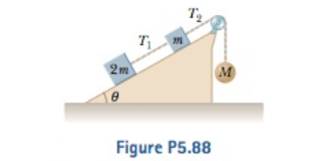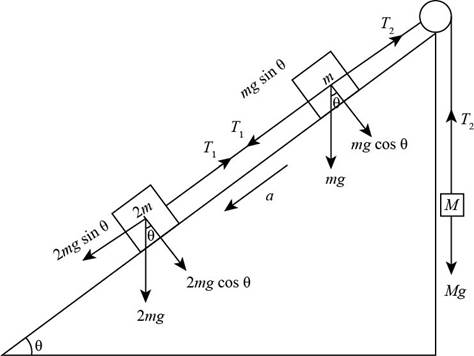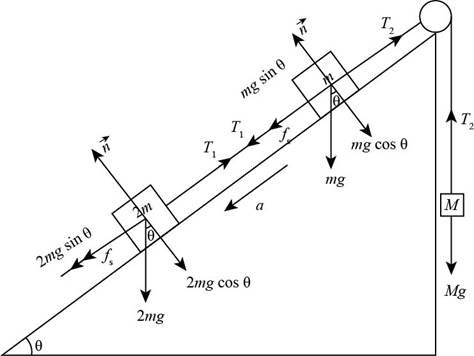
Concept explainers
Consider the three connected objects shown in Figure P5.88. Assume first that the inclined plane is friction-less and that the system is in equilibrium. In terms of m, g, and θ, find (a) the mass M and (b) the tensions T, and T2. Now assume that the value of Af is double the value found in part (a). Find (c) the acceleration of each object and (d) the tensions T1 and T2. Next, assume that the coefficient of static friction between m and 2m and the inclined plane is m, and that the system is in equilibrium. Find (e) the maximum value of M and (0 the minimum value of M. (g) Compare the values of T2 when M has its minimum and maximum values.

(a)
The expression for the mass of
Answer to Problem 5.88AP
The expression for the mass
Explanation of Solution
The free body diagram of the three connected objects is shown in Figure below,

Figure (1)
From Figure (1), the equilibrium forces acts on the object of mass
Here,
From the Newton’s second law of motion, the net force on the object of mass
Here,
Substitute
From Figure (1), the equilibrium forces act on the object of mass
Here,
From the Newton’s second law of motion, the net force on the object of mass
Substitute
Add the equation (1) with equation (2).
From Figure (1), the equilibrium forces act on the object of mass
Here,
Substitute
From the Newton’s second law of motion, the net force on the object of mass
Substitute
The system is in equilibrium so value of the acceleration is zero.
Substitute
Conclusion:
Therefore, the expression for the mass
(b)
The expressions for tensions
Answer to Problem 5.88AP
The expression for the tension
Explanation of Solution
From part (a), the expression for the mass of
From part (a), the equilibrium forces act on the object is,
The system is in equilibrium, the value of acceleration is zero so the net force acts on the system is also zero.
Substitute
Substitute
Thus, the expression for the tension
From part (a), the equation (2) is,
Substitute
Substitute
Thus, the expression for the tension
Conclusion:
Therefore, the expression for the tension
(c)
The acceleration of each object.
Answer to Problem 5.88AP
The acceleration of each object is
Explanation of Solution
Given info: The value of mass
From part (a), the expression for the mass when it is double represents as,
From part (a), the equation (1) is,
Rearrange the above equation.
From part (a), the equation (2) is,
Rearrange the above equation.
Substitute
From Figure (1), the equilibrium forces act on the object of mass
Substitute
Subtract the equation (3) from equation (4).
Conclusion:
Therefore, the acceleration of each object is
(d)
The expressions for tensions
Answer to Problem 5.88AP
The expression for the tension
Explanation of Solution
From part (c), the expression for the acceleration is,
From part (c), the equation for tension
Substitute
Thus, the expression for tension
From part (c), the equation (3) is,
Substitute
Thus, the expression for tension
Conclusion:
Therefore, the expression for the tension
(e)
The maximum value of
Answer to Problem 5.88AP
The maximum value of
Explanation of Solution
Given info: The coefficient of static friction between mass
The static friction forces on the masses

Figure (2)
From the Figure (2), the normal force on the object of mass
The expression for the static friction force on the object of mass
Here,
Substitute
From the Figure (1), the equilibrium forces acts on the object of mass
Substitute
Rearrange the above equation for
Substitute
From the Figure (2), the normal force on the object of mass
Substitute
From the Figure (1), the equilibrium forces acts on the object of mass
Substitute
Add equation (4) with the above equation.
Substitute
The equilibrium forces on the block of mass
Substitute
Conclusion:
Therefore, the maximum value of
(f)
The minimum value of
Answer to Problem 5.88AP
The minimum value of
Explanation of Solution
From part (e), the expression of tension
The equilibrium forces acts on block for minimum mass of
Substitute
Conclusion:
Therefore, the minimum value of
(g)
The difference between the tension
Answer to Problem 5.88AP
The difference between the tension for maximum and minimum mass is
Explanation of Solution
From part (e), the expression for maximum mass is,
From part (f), the expression for the minimum mass is,
From part (e), the expression for the tension for maximum mass is,
From part (f), the expression for the tension for maximum mass is,
Compare both the above equation.
Substitute
Conclusion:
Therefore, the difference between the tension for maximum and minimum mass is
Want to see more full solutions like this?
Chapter 5 Solutions
EBK PHYSICS FOR SCIENTISTS AND ENGINEER
- Two-point charges of 5.00 µC and -3.00 µC are placed 0.250 m apart.a) What is the electric force on each charge? Include strength and direction and a sketch.b) What would be the magnitude of the force if both charges are positive? How about the direction? c) What will happen to the electric force on each piece of charge if they are moved twice as far apart? (Give a numerical answer as well as an explanation.)arrow_forwardy[m] The figure shows two snapshots of a single wave on a string. The wave is traveling to the right in the +x direction. The solid line is a snapshot of the wave at time t=0 s, while the dashed line is a snapshot of the wave at t=0.48s. 0 0.75 1.5 2.25 3 8 8 6 6 4 2 4 2 0 -2 -2 -4 -4 -6 -6 -8 -8 0 0.75 1.5 2.25 3 x[m] Determine the period of the wave in units of seconds. Enter your numerical answer below including at least 3 significant figures. Do not enter a fraction, do not use scientific notation.arrow_forwardNo chatgpt pls will upvotearrow_forward
- An extremely long, solid nonconducting cylinder has a radius Ro. The charge density within the cylinder is a function of the distance R from the axis, given by PE (R) = po(R/Ro)², po > 0.arrow_forwardAn extremely long, solid nonconducting cylinder has a radius Ro. The charge density within the cylinder is a function of the distance R from the axis, given by PE (R) = po(R/Ro)², po > 0.arrow_forwardA sky diver of mass 90 kg (with suit and gear) is falling at terminal speed. What is the upward force of air drag, and how do you know?arrow_forward
- A car is traveling at top speed on the Bonneville salt flats while attempting a land speed record. The tires exert 25 kN of force in the backward direction on the ground. Why backwards? How large are the forces resisting the forward motion of the car, and why?arrow_forwardA bee strikes a windshield of a car on the freeway and gets crushed. What can you conclude about the force on the bee versus the force on the windshield, and on what principle is this based?arrow_forwardNo chatgpt plsarrow_forward
- No chatgpt plsarrow_forwardPlease help by: Use a free body diagram Show the equations State your assumptions Show your steps Box your final answer Thanks!arrow_forwardPlease help by: Use a free body diagram Show the equations State your assumptions Show your steps Box your final answer Thanks!arrow_forward
 Principles of Physics: A Calculus-Based TextPhysicsISBN:9781133104261Author:Raymond A. Serway, John W. JewettPublisher:Cengage Learning
Principles of Physics: A Calculus-Based TextPhysicsISBN:9781133104261Author:Raymond A. Serway, John W. JewettPublisher:Cengage Learning Physics for Scientists and Engineers, Technology ...PhysicsISBN:9781305116399Author:Raymond A. Serway, John W. JewettPublisher:Cengage Learning
Physics for Scientists and Engineers, Technology ...PhysicsISBN:9781305116399Author:Raymond A. Serway, John W. JewettPublisher:Cengage Learning Physics for Scientists and Engineers: Foundations...PhysicsISBN:9781133939146Author:Katz, Debora M.Publisher:Cengage Learning
Physics for Scientists and Engineers: Foundations...PhysicsISBN:9781133939146Author:Katz, Debora M.Publisher:Cengage Learning Classical Dynamics of Particles and SystemsPhysicsISBN:9780534408961Author:Stephen T. Thornton, Jerry B. MarionPublisher:Cengage Learning
Classical Dynamics of Particles and SystemsPhysicsISBN:9780534408961Author:Stephen T. Thornton, Jerry B. MarionPublisher:Cengage Learning University Physics Volume 1PhysicsISBN:9781938168277Author:William Moebs, Samuel J. Ling, Jeff SannyPublisher:OpenStax - Rice University
University Physics Volume 1PhysicsISBN:9781938168277Author:William Moebs, Samuel J. Ling, Jeff SannyPublisher:OpenStax - Rice University Physics for Scientists and Engineers with Modern ...PhysicsISBN:9781337553292Author:Raymond A. Serway, John W. JewettPublisher:Cengage Learning
Physics for Scientists and Engineers with Modern ...PhysicsISBN:9781337553292Author:Raymond A. Serway, John W. JewettPublisher:Cengage Learning





